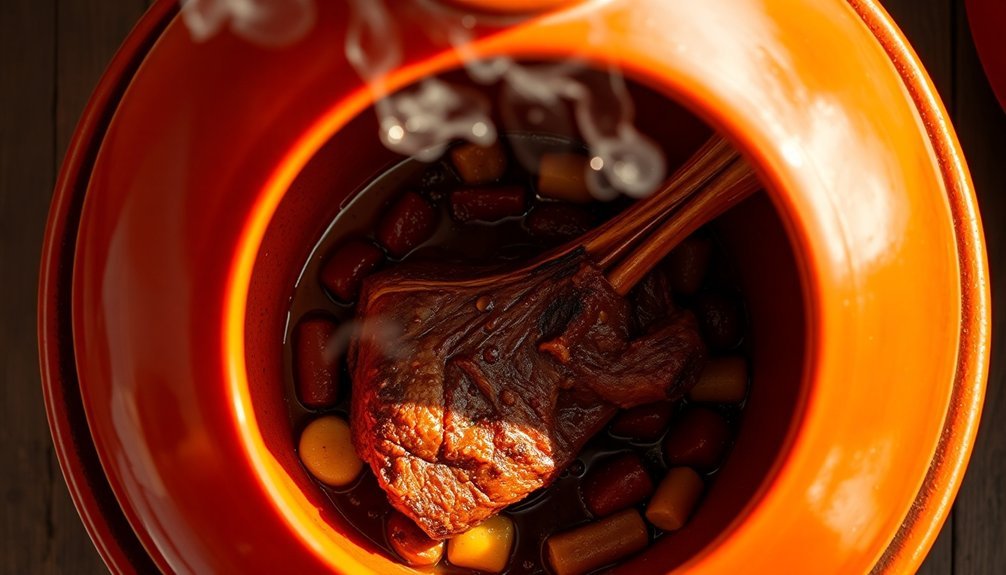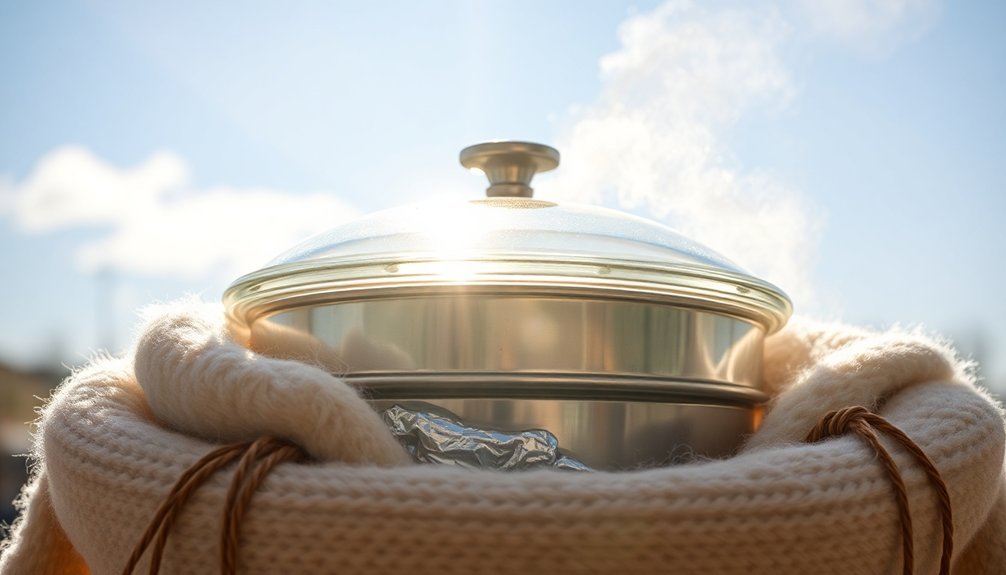When sun-baking meals, you'll want to use three proven moisture-locking techniques to maintain flavor and texture. Start with the double-lid sealing method, which creates five interlocked layers for an airtight barrier that keeps moisture from escaping. Next, implement a steam-lock chamber design to maintain precise temperature and humidity levels throughout the cooking process. Finally, wrap your cooking pot with layers of heavy-duty foil and bubble wrap, which can reduce temperatures by up to 13.6 degrees while sealing in precious moisture. These techniques will enhance your meal's preservation and help you achieve professional-level results in your solar cooking journey.
Double-Lid Moisture Sealing Method

Ever wondered how professional food manufacturers keep their canned goods fresh for months? The secret lies in a precise double-lid moisture sealing method that creates an airtight barrier through five interlocked layers of material.
You'll find this technique relies on a two-stage roller operation. First, a roller hooks the lid's flange over the can's edge. Then, a second roller applies pressure to form a hermetic seal that locks out moisture and contaminants. This highly automated approach ensures fast production speeds, making it ideal for large-scale manufacturing.
The process works with various materials, including tin, steel, and aluminum, making it versatile for different packaging needs.
When you're examining a sealed can, you're looking at an engineering marvel where the lid and can body are permanently interlocked. This efficient process guarantees your food stays fresh with minimal maintenance, protecting contents from degradation for extended periods.
Steam-Lock Cooking Chamber Design
Professional chefs rely on steam-lock cooking chambers to maintain precise temperature control and moisture levels in their dishes.
To maximize efficiency, you'll need to install float-thermostatic traps near drain points, as they handle large volumes of condensate at low pressure. Regular maintenance schedules and system monitoring are crucial for long-term reliability.
You'll want to position air vents opposite the steam inlet to guarantee thorough air removal and maintain dry saturated steam.
For tilting pans, it's vital to use traps with steam lock release features to prevent condensate backup. Be certain to adjust the needle valve correctly for peak performance.
Choose stainless steel components when working with acidic condensate, and don't forget to include strainers to protect your traps from debris.
Regular cleaning of trap sets will keep your steam-lock chamber functioning at maximum efficiency, assuring consistent cooking results.
Solar Pot Wrapping Techniques

While traditional heat retention methods can be cumbersome, solar pot wrapping offers a simple yet effective solution for temperature control.
You'll need just a few materials: heavy-duty foil, bubble wrap, clear packaging tape, and basic measuring tools.
Start by measuring your pot's circumference and height, then cut bubble wrap to match these dimensions.
Create a sandwich by laying the bubble wrap between two layers of foil that's twice the length of your wrap. Secure everything with clear packaging tape.
This technique can lower pot temperatures by up to 13.6 degrees compared to unwrapped containers, making it ideal for protecting plants from heat stress. Testing in Phoenix's extreme heat demonstrated remarkable effectiveness of this method.
You'll find it's faster and cleaner than painting pots white, and you can easily adapt it for different pot sizes in your garden.
Frequently Asked Questions
Can Sun-Dried Foods Be Safely Rehydrated Using Cold Water Methods?
Yes, you can safely rehydrate sun-dried foods using cold water. Simply cover your dried items with cold water and let them soak overnight. It's slower than hot water methods, but equally effective.
How Does Altitude Affect Moisture Retention in Solar Cooking?
At higher altitudes, you'll experience faster moisture loss due to lower atmospheric pressure. You'll need to add more liquid (up to 25% extra), use tight-fitting lids, and adjust cooking times for successful solar cooking.
What Materials Should Be Avoided When Sealing Moisture in Solar Ovens?
You'll want to avoid aluminum foil, tightly sealed jars, and cans without ventilation holes. Don't use overly tight lids or reflective materials, as they can cause dangerous pressure buildup and interfere with proper heating.
Do Different Food Combinations Affect Condensation Levels During Solar Cooking?
Yes, your food combinations will affect condensation levels. If you're mixing high-moisture foods like vegetables with drier items, you'll get more condensation than cooking similar-moisture foods together.
Can Vacuum Sealing Replace Traditional Moisture-Locking Techniques in Solar Cooking?
Yes, you'll find vacuum sealing is superior to traditional moisture-locking methods. It maintains higher temperatures, reduces moisture loss, and eliminates the need for venting. You won't have to worry about steam buildup during cooking.
In Summary
You'll find these three moisture-locking methods make all the difference in your sun-cooked meals. By combining the double-lid sealing system, steam-lock chamber design, and strategic pot wrapping, you're ensuring maximum moisture retention and even cooking. Don't let the sun's intensity dry out your dishes – put these techniques to work and enjoy perfectly moist, flavorful solar-cooked meals every time.





Leave a Reply